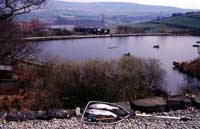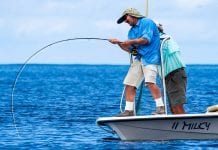 To the ‘Purist’, he’s an unwelcome visitor, a second-rate fish, definitely nothing to boast about to his friends should he have the misfortune to catch one, however large.
To the ‘Purist’, he’s an unwelcome visitor, a second-rate fish, definitely nothing to boast about to his friends should he have the misfortune to catch one, however large.
I’m talking about salmo gairdneri, that’s rainbow trout to the likes of you and me.
Introduced to Europe from America in the 1880`s, this fast-growing trout is more tolerant of higher temperatures and poor quality water than our own native brown trout. For these reasons, plus the fact that rainbows are able to convert food proteins into body mass at such a fast rate, it’s no wonder that he is so popular with trout anglers and owners of trout fisheries up and down the country.
Much has been written on the subject of tackle and tactics with regard to the rainbow trout and every angler will have his own ideas when it comes to what constitutes the ideal set-up for tackling rainbows. A lot will depend upon what sort of water you fish, for example, it’s no use trying to thrash every ounce out of a delicate brook rod when desperately trying to cover a rise of a fish 25yds away, and by the same token, casting to an awkward-lying fish close to your own bank will not necessitate the use of a powerful reservoir rod.
My first trout fly rod was purchased some 25 years ago. It was a Hardy Fibalite which threw a No.6 line. The rod served me well on my local waters in Hampshire but a new rod building material was starting to make an appearance – carbon fibre. Nowadays, I would suggest that carbon fibre is the material from which to build a rod, any rod.
The lovers of cane would have you believe that there is nothing to touch the feeling of a hand-built rod, lovingly produced by a master cane splitter over many, many hours of dedicated toil. Indeed, I would tend to agree that a handmade rod is a thing of pure beauty and a joy to behold but, they are very expensive and one clumsy step with a heavy boot can lead to both tears and pain, not to mention an empty wallet!
My current fly rod is a two-piece carbon rod, 9ft 6in with screw-down reel fittings with Fuji guides. It was bought in the early eighties soon after I got rid of the Hardy rod.
The thing that I love about this rod is the fact that it’s so versatile, it’ll drop a fly exactly where you want it every time. Not only that, but it will also allow me to use lines from AFTM 6 to 8, floaters and sinkers.
With the advances in modern rod-building technology my fly rod probably wouldn’t share many of the advantages that today’s rods have, but I know what my rod is capable of and it has grown to be a part of me (well almost)!!!
Fly reels are basically all the same, a simple drum onto which the flyline is wound and usually comes complete with a ratchet. The important thing to look for is that the drum should be sufficiently large in diameter otherwise you will find that the flyline will form into tight coils on the spool. The reel should also possess an exposed rim, allowing running fish to be controlled by exerting finger pressure on it.
Ideally of course, two reels will be required. A floating line on one and a sinker on the other.
Fly lines come in a bewildering array of sizes, colours, tapers, floaters etc, etc. You will need to match the line to the rod that you have.
As previously mentioned, my trout fishing is limited to the counties of the south coast and for the type of waters that I fish, I find that a # 7 double tapered floater fits the bill very nicely when I’m fishing up in the water, or when nymph fishing with a long tapered leader.
For deeper work, perhaps when the weather is cold and the trout show little interest in rising to surface flies, I use a # 7 double tapered sinker for exploring the deeper water, usually in conjunction with a lure rather than an imitative type of fly.
Please understand that these are only my personal preferences, some of the guys that I meet on the bankside would tell you to go out and buy a Weight Forward line or a shooting-head for distance work.
As with any of the other branches of angling, your best bet is to talk to other anglers that you meet, see what tackle they are using. Don’t worry too much about specific makes of tackle but concentrate more on specifications such as rod length and rating, reel diameters and taper and weight of flyline, whether it be a floater, sinker, sink-tip or an intermediate.
Having sorted out rod, reel and flyline, the next essential is the leader.A length of nylon, one end of which is knotted to the end of the flyline, the other end to either the fly itself, or to an extra length of nylon called a “tippet”.The purpose of the tippet, primarily, is to allow you several changes of fly without having to keep shortening the length of the leader every time you re-tie your knot.
The leader itself can be made by the angler, either from several lengths of nylon knotted together, a simple level length of nylon, or alternatively, a tapered leader can be purchased from a tackle shop.
The purpose of the leader is to present the fly in a delicate manner as naturally as possible away from the potentially fish-frightening flyline. It should also allow the fly to be presented either in or on the water. I tend to use a level length of nylon when fishing a lure on a sinking line but when I’m using imitative patterns of fly, I prefer to use a tapered leader as this presents the fly much more delicately. Whichever leader you use, be sure to de-grease the last few feet as this will allow the leader to sink making it less conspicuous to the trout.
Last, but by no means least, are the flies that will be needed to actually catch the fish, or at least, deceive him into taking. I would suggest that to start off with you will need some imitative patterns, some lures and a few traditional flies.
Every angler has his own favourites when it comes to flies and, like the coarse angler with his float collection, you will end up with far more flies than you will ever need.
Some of my favourite imitative patterns include a number of midge pupae and sedge pupae, in different colours and sizes. Nymphs such as the Damselfly, Mayfly, Pheasant-tail, Amber nymph and Gold-Ribbed Hare’s Ear and patterns such as Shrimps, Bugs, Crane-fly, Corixae also form the front line of my attack.
Lures come in all shapes, colours and sizes. A selection should include patterns such as Baby-Dolls, Boobys, Undertaker, Ace of Spades, Worm Fly, Muddler Minnow and Sweeney Todd. As you will see in the tackle shop, there are plenty of others to choose from, some of which should carry a government health warning, especially the ones that look like Christmas trees with all the lights on!
The traditional flies come in wet or dry variations and are always a welcome addition to my fly box, although I must admit to not being a great fan of their use.Certainly try to include the Grey Duster, William’s Favourite, Greenwell’s Glory and the Tups Indispensable in the dry fly selection.
If your wet fly selection includes the Dunkeld, Mallard and Claret and the Invicta, you will have some really good trout takers.
Finally, do try above all to enjoy your fishing and always respect the Countryside Code.












